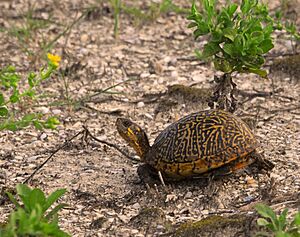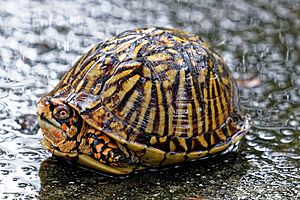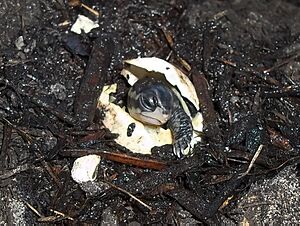Florida box turtle facts for kids
The Florida box turtle (Terrapene carolina bauri) is a special kind of turtle. It belongs to the same family as many other turtles, called Emydidae. It is one of four different types, or subspecies, of the common box turtle.
Quick facts for kids Terrapene carolina bauri |
|
|---|---|
 |
|
| Terrapene carolina bauri | |
| Conservation status | |
| Scientific classification |
|
| Kingdom: | Animalia |
| Phylum: | Chordata |
| Class: | Reptilia |
| Order: | Testudines |
| Suborder: | Cryptodira |
| Family: | Emydidae |
| Genus: | Terrapene |
| Species: | |
| Subspecies: |
T. c. bauri
|
| Trinomial name | |
| Terrapene carolina bauri Taylor, 1895
|
|
| Synonyms | |
Contents
What's in a Name?
The second part of the turtle's scientific name, bauri, honors a scientist named Georg Baur. He was a herpetologist, which means he studied reptiles and amphibians.
Where They Live
The Florida box turtle lives the furthest south of all the common box turtle types. You can find them only in the U.S. state of Florida. They also live in a small part of southeastern Georgia.
These turtles are found all over mainland Florida. They have also been seen on the Florida Keys. You can also spot them on the barrier islands in the Gulf of Mexico off Florida's west coast.
Their Home (Habitat)
Florida box turtles like places that are a bit wet. You can find them in wetlands, marshlands, and near swamps. However, they usually do not go into water that is deep enough for them to swim.
They often live in flatwoods, upland areas, and moist forests. Young turtles like places with lots of plants and leaves on the ground. They also prefer moist soil. Adult turtles can live in more open areas.
Temperature and Humidity
- Daytime air temperature: 70 - 90°F (21 - 32°C)
- Basking temperature: 85 - 95°F (29 - 35°C)
- Humidity: 70 - 90%
What They Look Like
Like other box turtles, the Florida box turtle has a tall, rounded shell. It also has a special hinged bottom shell, called a plastron. This hinge lets the turtle close its shell very tightly. This helps protect it from danger.
The Florida box turtle looks different from other types of Terrapene carolina. Its top shell, called a carapace, has bright yellow stripes. These stripes make it easy to tell them apart. The bottom shell can be all yellow, all black, or a mix of both.
These turtles have very sharp claws. They also have a sharp beak. They use their beak to catch small insects. They also eat fruits, vegetables, and mushrooms.
Males and Females
Male and female Florida box turtles look a bit different. This is called sexual dimorphism. Males are usually longer and wider than females. Female shells are typically 12.1 to 15.8 cm long. Male shells can be 12.8 to 17.3 cm long.
However, female shells are often taller than male shells. This extra height likely gives them more room for eggs inside their body.
How They Behave
Florida box turtles spend most of their lives (80-90%) hidden. They often bury themselves in plants or underground. Their activity changes a lot throughout the year.
During the dry, cool months (November to February), they are less active. They enter a quiet stage and are hard to find. They are much more active during the warm, wet months (April to October).
Unlike some other box turtles, they don't go into a full dormant state in winter. This is because Florida has warm, steady temperatures. So, they stay active for more of the year than other box turtles. They don't handle cold weather as well as other types.
What They Eat
The Florida box turtle eats many different things. It is an omnivore, meaning it eats both plants and animals. Their diet is similar to other box turtles.
They often eat snails and low-hanging fruits. They also munch on leafy plants like shrubs, herbs, and grasses. Insects, crabs, and mushrooms are also on their menu. They have even been seen eating dead animals and garbage.
Helping Plants Grow
Florida box turtles help spread the seeds of many plants. They do this by eating fruits. When they move around, they drop the seeds in new places. Most of these plants have fruit, like wild custard apple or sea grape. Some plants they help spread don't have fruit, like certain grasses.
Reproduction and Life Cycle
Florida box turtles can start having babies when they are about 12 to 13 years old. Some turtles only lay one group of eggs, called a clutch, per year. But the Florida box turtle can lay up to four clutches in one year!
They lay eggs in the Spring season. This usually happens from April to early June. Each clutch typically has 1 to 9 eggs. The eggs are about 35 x 19 mm to 38.5 x 21 mm in size. Their eggs are a bit bigger than those of other common box turtles.
Bigger female turtles tend to lay more eggs. The eggs usually hatch after about 60 days. But it can take anywhere from 45 to 120 days.
More rain can lead to more baby turtles hatching. Also, turtles in northern areas tend to lay more eggs. The temperature of the eggs while they are developing can affect if they become male or female. Warmer temperatures usually lead to more females. Cooler temperatures result in more males.
How They Grow
Young Florida box turtles, called juveniles, have shorter and wider shells than adults. Their shells get longer as they grow. They grow quickly when they are young. Their growth slows down after they can have babies. It stops completely a few years later, around 16 or 17 years old. Even though they are more active, Florida box turtles grow slower each year than other box turtle types.
Dangers and Protection
The Florida box turtle is listed as a "vulnerable species" by a group called IUCN. This means their populations are at risk.
Many things threaten these turtles:
- Predators: Animals like raccoons, possums, foxes, and birds eat their eggs and young turtles.
- Habitat Loss: Their homes are being destroyed or changed.
- Cars: Turtles are often hit by cars on roads.
- Pollution: Pesticides and other pollution can harm them.
- Pet Trade: Some people collect them from the wild to keep as pets or for turtle racing.
Wildfires
Wildfires in Florida can be very dangerous for box turtles. A fire can kill almost half of a turtle population. However, fewer turtles die in fires during the dry season. This might be because they are less active and spend more time underground when it's dry.
Keeping Them as Pets
Florida box turtles can be kept as pets. They eat a wide variety of foods in the wild. If you keep them as pets, they especially like live food. This includes earthworms, crickets, locusts, snails, and wax worms. Wax worms should only be given as a treat because they have a lot of fat. They also like superworms and even baby mice.
You can also offer them chopped fruits and vegetables. They might not eat them as eagerly, but finely grated dark green veggies like lettuce and kale are good. Fruits like melons, berries, and cantaloupe can be given once or twice a week.
Laws About Owning Them
In Florida, you are usually not allowed to own more than two Florida box turtles. If you own three or more without a special permit, you could be fined. The turtles might also be taken away. This type of turtle is only found in Florida and is protected in many other places too. Many pet stores sell baby turtles, which are often healthier than turtles caught from the wild.
See also
 In Spanish: Terrapene carolina bauri para niños
In Spanish: Terrapene carolina bauri para niños





